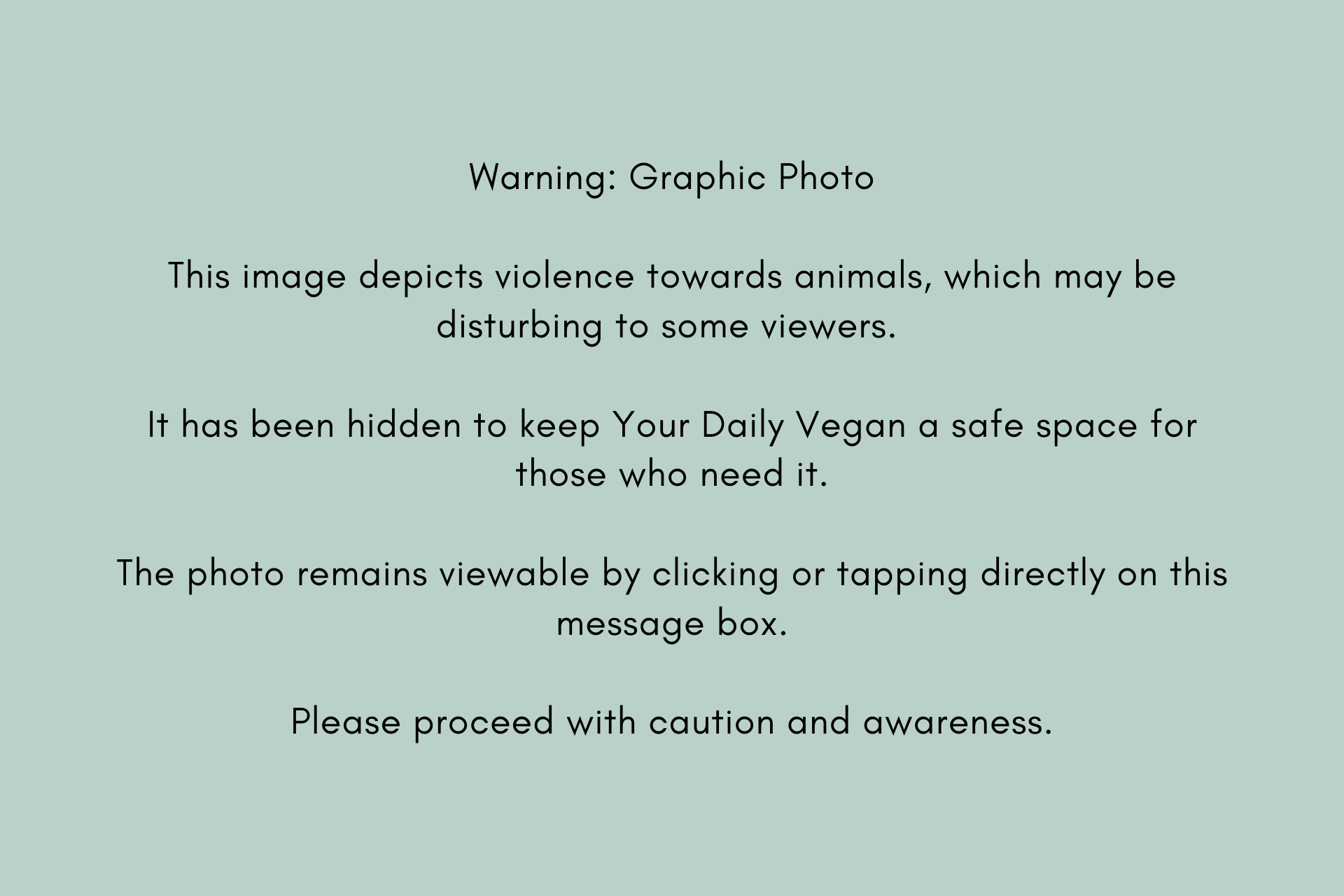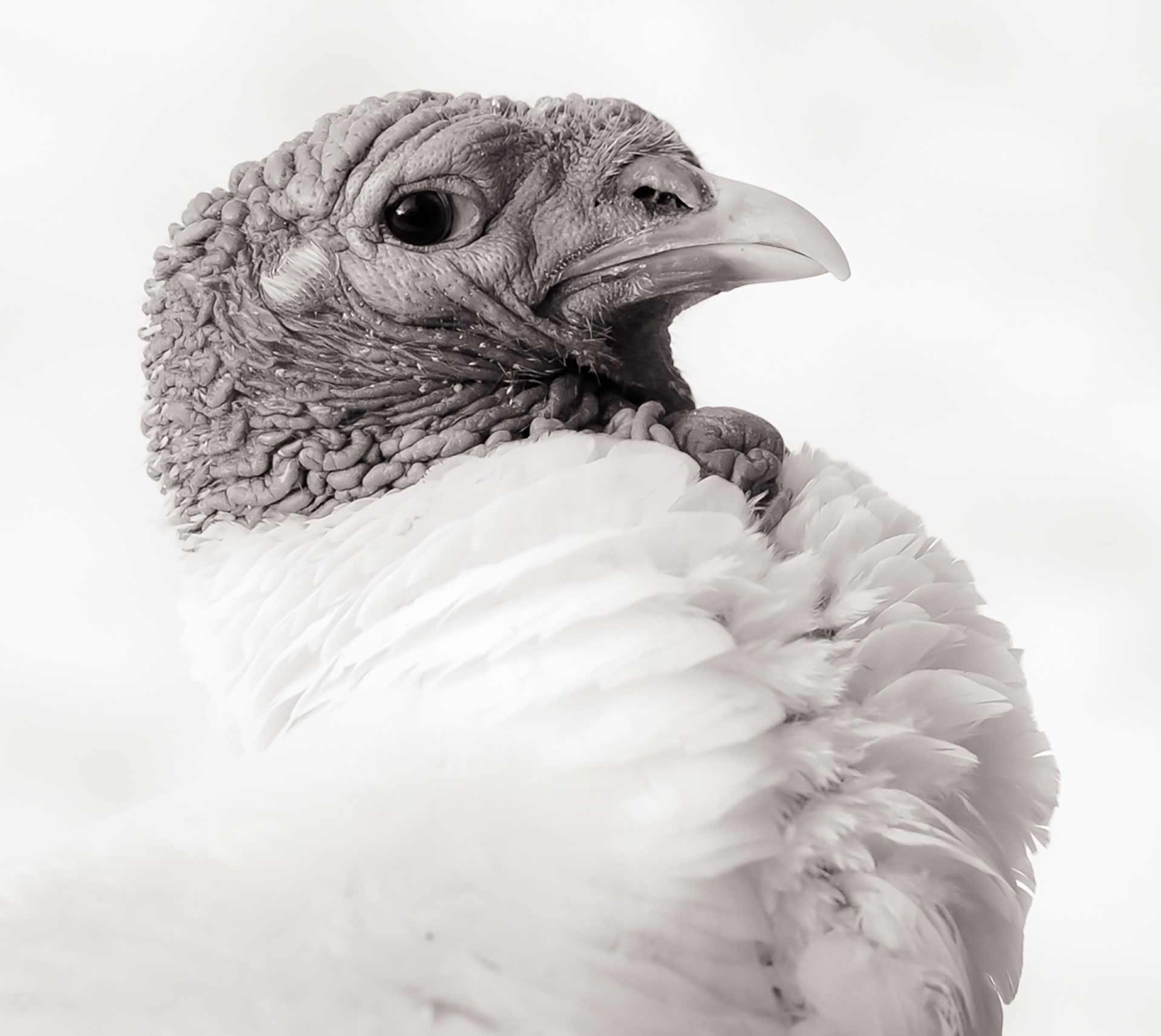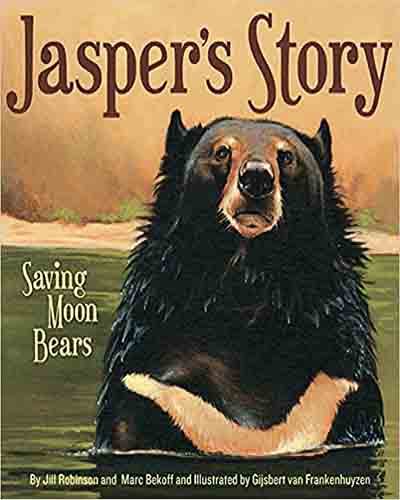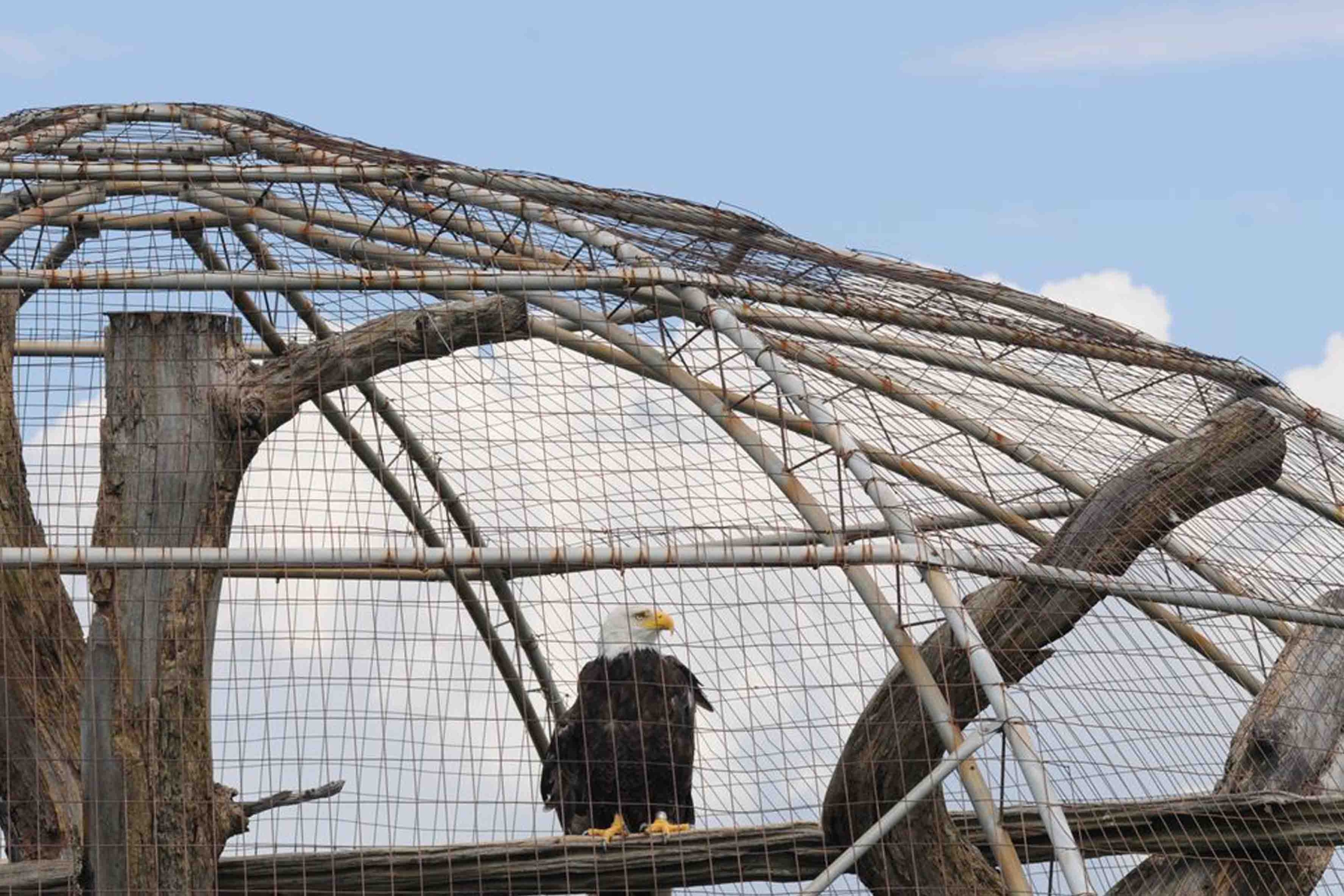
Published: February 2014
Last Update: February 2023
Reading Time: 26 minutes
Zoos are prisons for animals
Despite their commonly cited benefits, zoos are no home sweet home for animals. Even at their best, they can never replicate or replace animals’ chosen and natural habitats.
Animals are either taken from their home or born into captivity where they are prevented from doing things that are natural to them like running, roaming, flying, climbing, foraging, choosing a mate, raising a family, and being with others of their species.
It’s a business where the babies draw crowds, and adult animals are routinely traded, loaned, or sold. The disposal of older (“surplus”) animals is a not-so-well-kept secret (and sometimes illegal) industry practice.
Animals end can end up at auction, on a hunting ranch, in research laboratories, or dying in a more depraved situation.
So, do vegans support zoos? They shouldn’t, and neither should you.
Let’s debunk some myths.
QUICK NAVIGATION
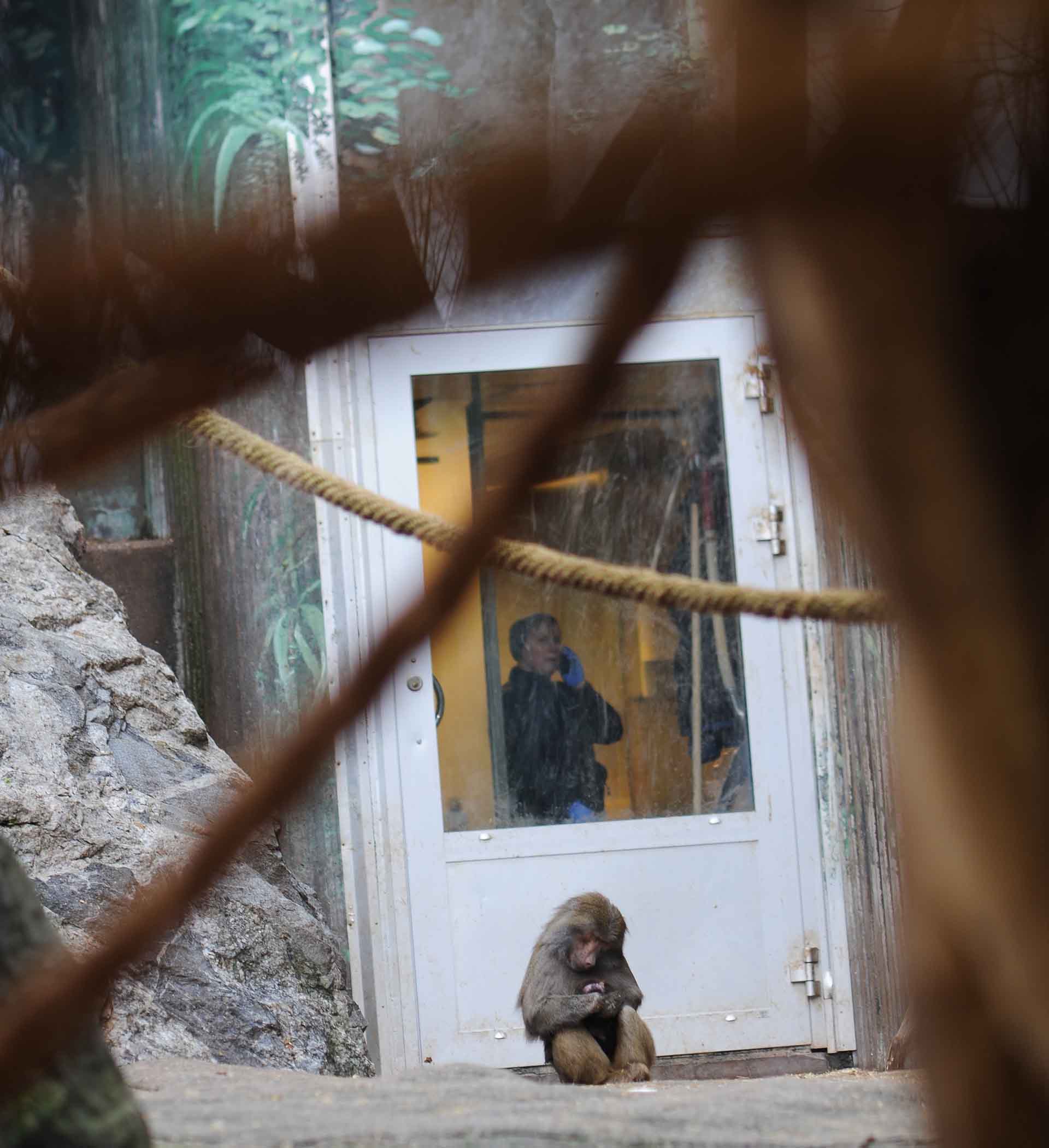
Hamadryas Baboons on display at a zoo in Sweden / Source
1. Zoo business
At their core, zoos are nothing more than a business.
The business of caging animals
According to the Association of Zoos and Aquariums, over 183 million people visit zoos and aquariums each year in the United States, and over 200 million worldwide. That's more than the NFL, NBA, NHL, and MLB annual attendance combined. (1)
Two out of three adults will visit with a child. A whopping 93% of people say that they enjoy seeing animals up close. (1)
Zoological parks enjoy immense popularity, overwhelmingly positive popularity. Often they're seen as sanctuaries whose primary goals are the conservation and care of a wide variety of animal species.
But like other industries that rely upon animals, this idea is little more than another humane myth.
And it's a recent one, too.

The monkey cage in the Schönbrunn Zoo at the end of 19th century / Source
The origins of zoos
Historically, zoos were places of social entertainment, places people visited during leisure time. Animals were there for the amusement of visitors. (2)
Early zoos had an emphasis on giving the public access to see the animals rather than on the needs of animals. There was little to no concern given to conservation either.
Then, people began having a growing dislike of capturing and caging animals for amusement. Zoos began to experience a decline in popularity (and probably a loss in income). Doomed, zoos transformed their image.
Instead of leisure spaces, they began to promote themselves as conservation places for species under the threat of extinction. This image shift happened sometime during the 1960s, though surprisingly, the original idea occurred sometime in the 1800s. (3)
But don't let this marketing campaign fool you; the reality and truth about zoos are straightforward.
Zoos exist as a recreational place for the human indulgence of gazing upon captive animals, nothing more. The capture and breeding of free-roaming animals, and sentencing them to an existence based solely on this desire, is a business.
A big one.
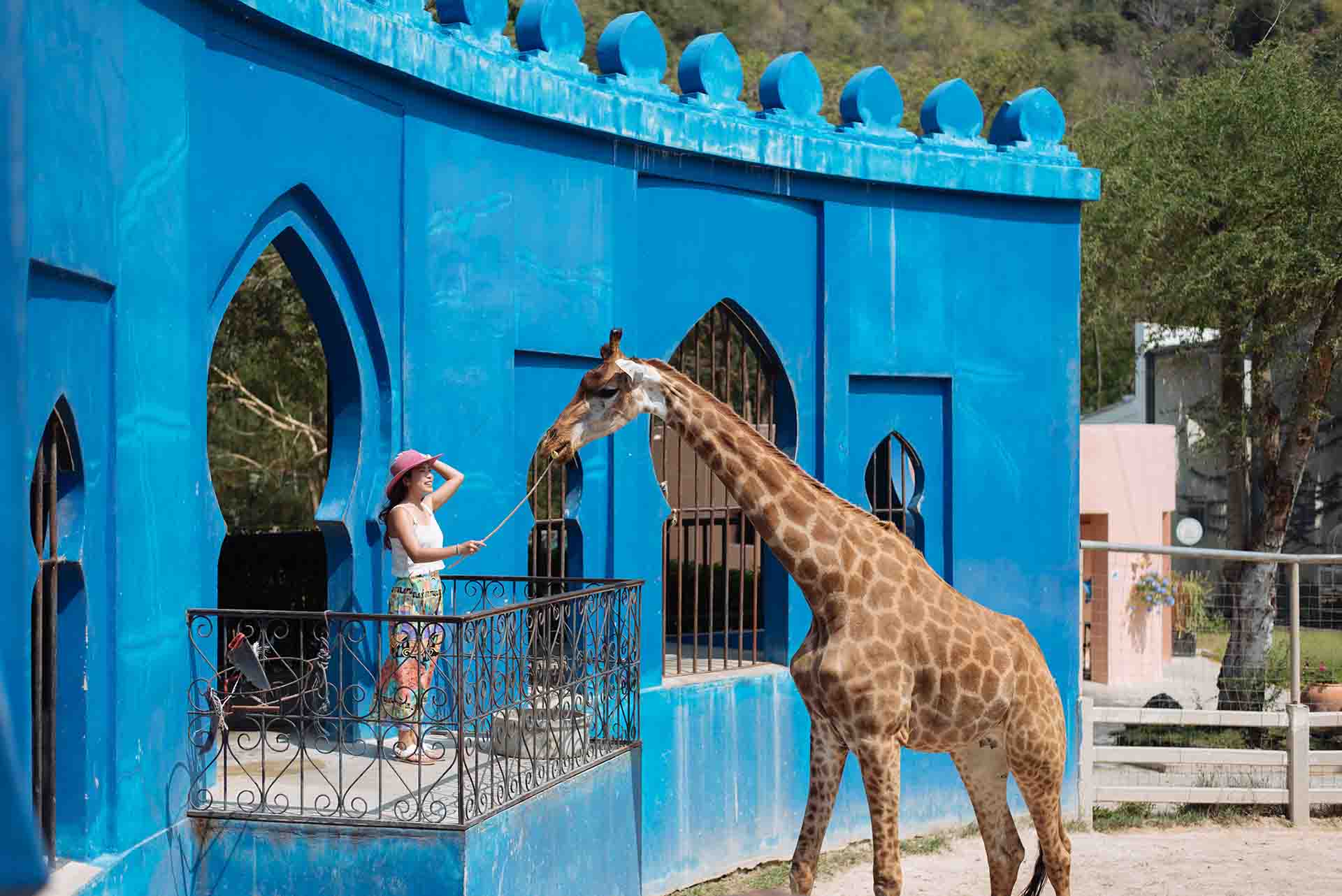
Person feeding a caged giraffe / Source
How zoos make money
Like any other business, zoos need funds to operate.
Zoos generally raise money in three ways; taxes or government support, philanthropy, and revenue from ticket and merchandise sales.
Some zoos run separate businesses to bring in additional revenue while others hold special catered events, serving animal-based meals under the guise of helping [different] animals.
Amusement is an essential function of zoos. People enjoy entertainment, and zoos need profits in the form of visitors. Without them, a zoo cannot remain open.
Remember, a zoo is nothing more than a business.
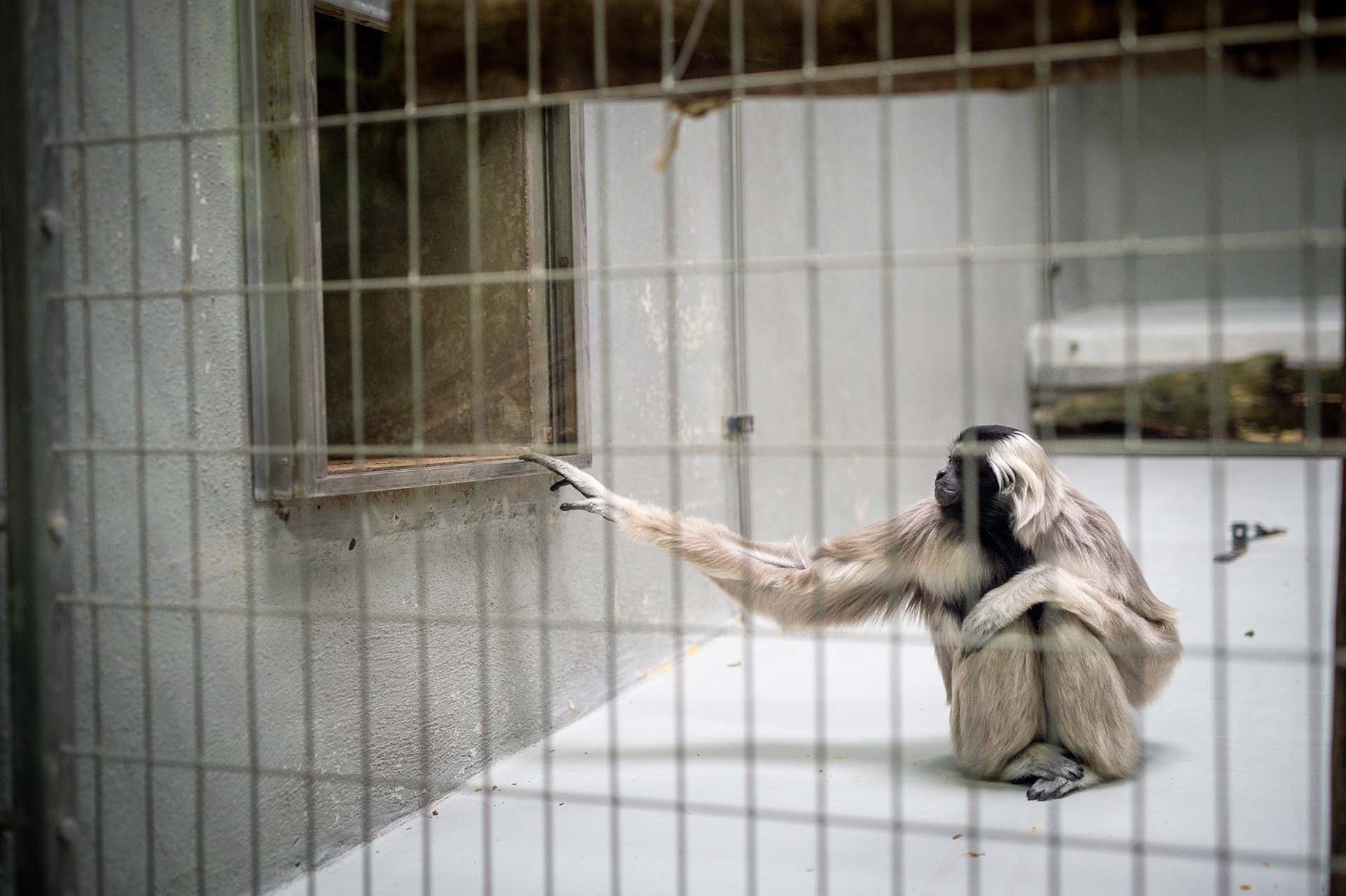
Pileated Gibbon At A Zoo In France / Source
Vegan thoughts on zoos
“I photograph at zoos regularly and I know that they are not all bad or ill-intentioned places . . . Many have adequate space, food, shelter and enrichment for the animals. Sadly, this is the exception rather than the norm” – JoAnne McArthur, weanimals.org (4)
"We need...to respect non-human animals, to want them to remain capable of living and moving freely in the habitats to which they've naturally adapted, rather than be alienated from those spaces. To leave birds in their forests rather than remove them and cage them as decorative or talkative pets; to let chimpanzees live in their natural territories rather than expect them to have babies in zoos and language labs..." - Lee Hall, Author On Their Own Terms (5)
Additional reading

Baltic Grey Seal on display in Lithuania / Source
2. Amusement
It's only fun for you.
Captivity Isn't Good for Animals
Zoos portray themselves as wonderful places filled with people who care deeply for animals. They insist the animals are happy and love their homes.
But that isn't the full truth.
Without a doubt, life in captivity differs significantly from what life would be in the wild.
Free-living animals can choose their environment and carry out instinctual behaviors necessary for survival. They control their social interactions, diet, and climate.
Captive animals, on the other hand, cannot. And this life in captivity may force animals to experience challenges they're not equipped to handle.
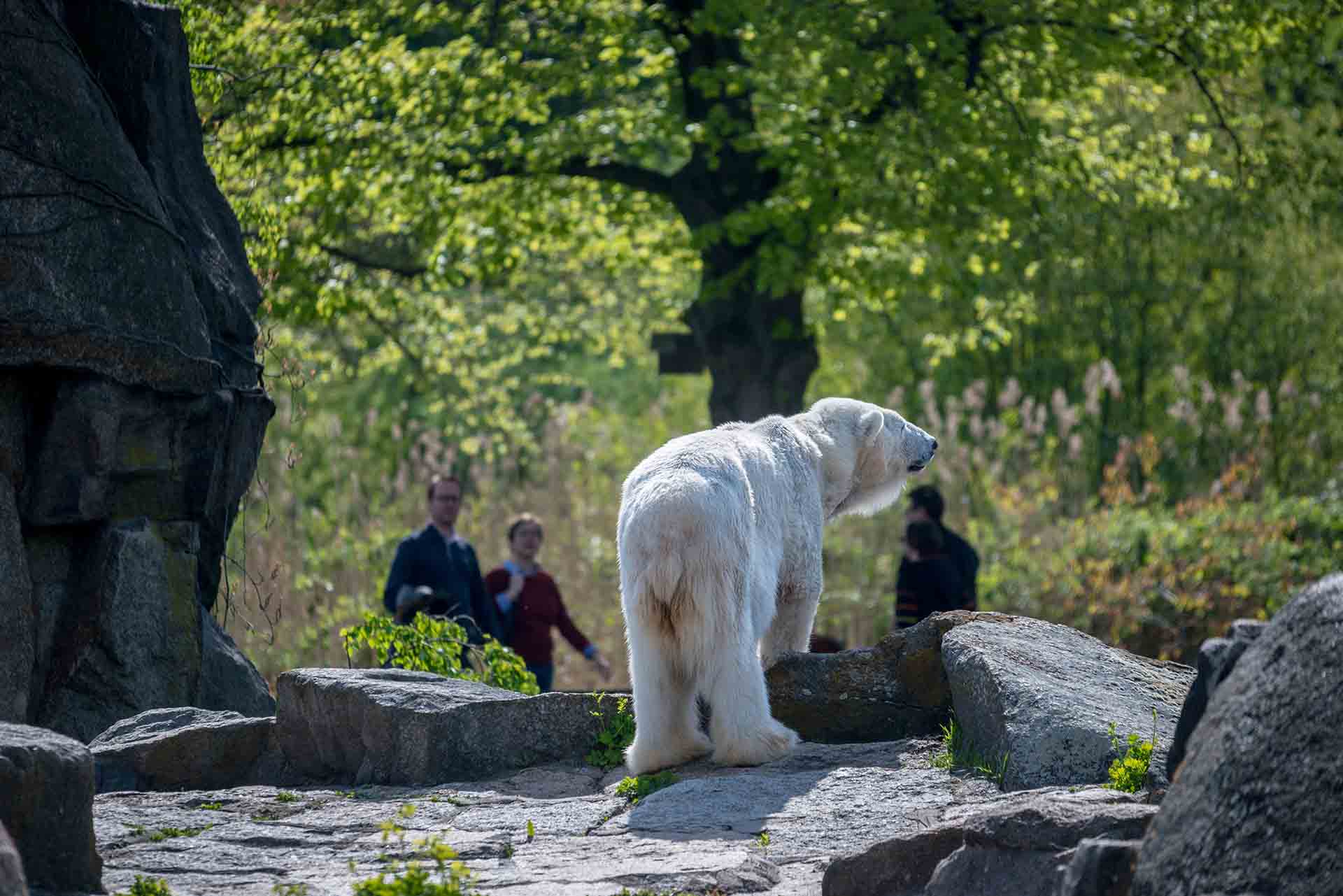
Polar Bear at a zoo in Germany / Source
Unnatural Habitats
Many zoos have enrichment programs, puzzles for play and stimulation, foods that may take longer to eat, ropes, or more complex structures added to their enclosures.
But try as they might, zoos can never replicate even a slim fraction of the kind of life animals could have in the wild.
Size Matters
Take Polar bears as an example. Because sea ice is vast and ever-changing, a polar bear's home range can be enormous. (6) Much more significant than any other species of bear, and more than a million times the size of an average zoo exhibit. (7) Lowland gorillas have a range of up to 4,600 square miles. (8)
Zoos simply don't have the land space to provide animals their natural ranges. And while enrichment is better than nothing, having a good or even great enclosure is still nothing more than a cage.
A lifetime spent in a cage is no life at all.

Visitors Watch A Gorilla At A Zoo In Germany / Source
Exhibits are for People, not Animals
It's worth repeating that zoos are, first and foremost, for people, not animals. You are their customer, and the design of each exhibit is with you in mind.
After all, an exhibit where you can't see the animal isn't much fun, is it?
Animals are there to look at, and that is a problem because most of them find this staring stressful.
The recessed gorilla exhibit at the San Francisco Zoo is an excellent example of this. Because of the recess, there's no glass surrounding the enclosure. Visitors look down at the gorillas. But being seen from above puts the gorillas in a vulnerable position, which in turn makes them feel uncomfortable. (7)
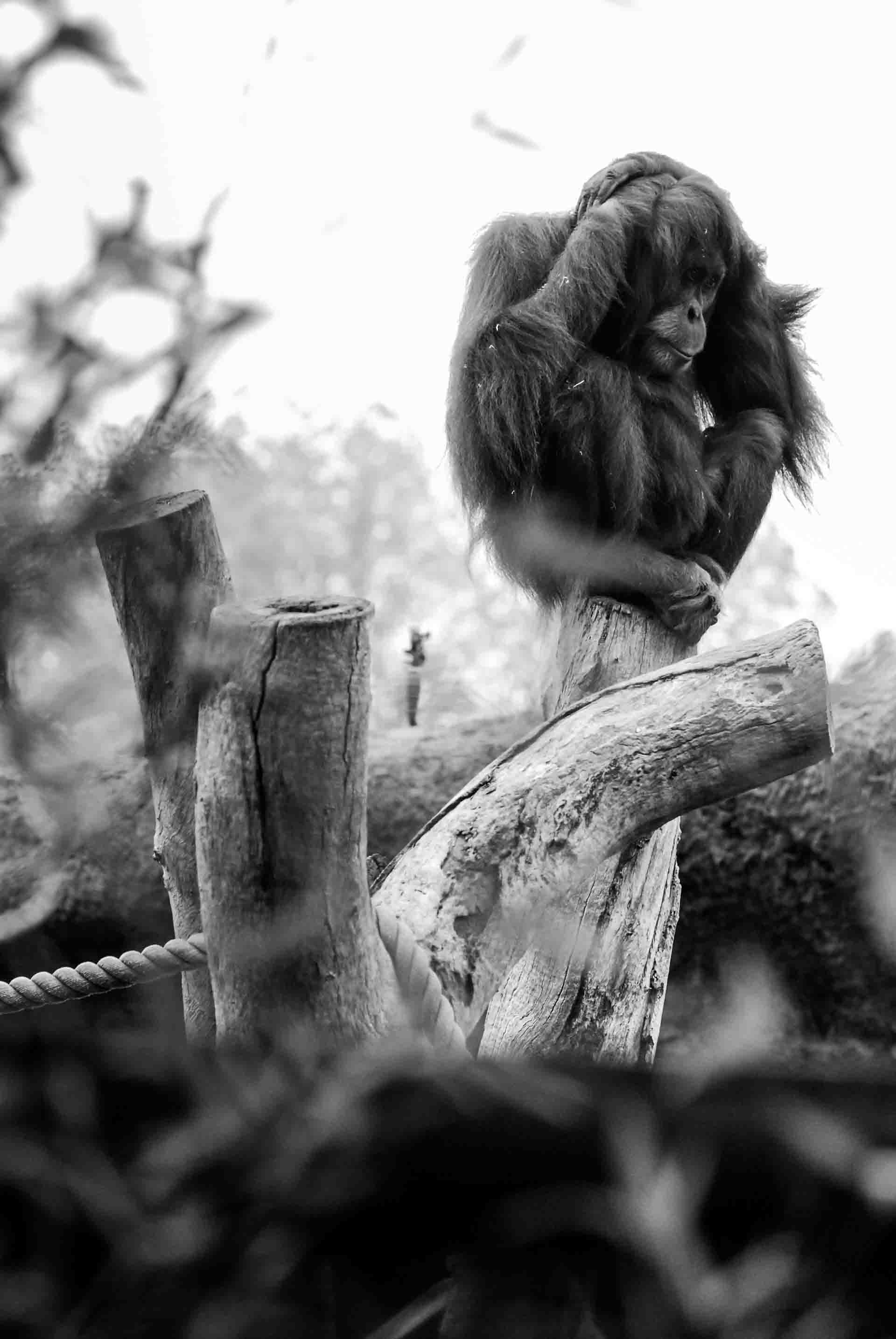
Orangutan at a zoo in Australia / Source
Unnatural Behaviors
Many animals deteriorate in captivity and begin to form poor health conditions or abnormal mental health problems. This deterioration may manifest in the development of physical disease or abnormal, stereotypic behaviors.
One common neurotic and atypical behavior is known as "Zoochosis."
Zoochosis occurs as a result of boredom, depression, frustration, impaired brain function, a lack of mental or physical enrichment, and removal from the animal's natural habitat and social structures. Repeated attempts to deal with a problem are also a cause. (9)
Signs of zoochosis include:
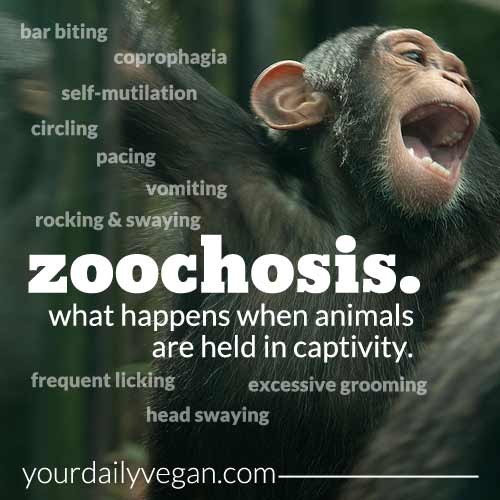
Pharmaceuticals, an Industry Secret
Treating stereotypic behavior can be complicated. One conventional treatment is the use of antidepressant and antipsychotic drugs, though it's very hush-hush in the industry.
Zoos are reluctant to tell people that zoo animals are depressed and need antidepressants to deal with their lives in captivity. Doing so could ruin their wholesome image of a place for family-friendly activities. (7)
Many zookeepers are asked to sign non-disclosure agreements, preventing them from talking about it.
Because of this, it's hard to get a lot of details about how many animals receive medications annually. What is known, however, is the animal health companies are doing quite well. In 2016, they produced $11.4 billion of medicines in the United States. (10)
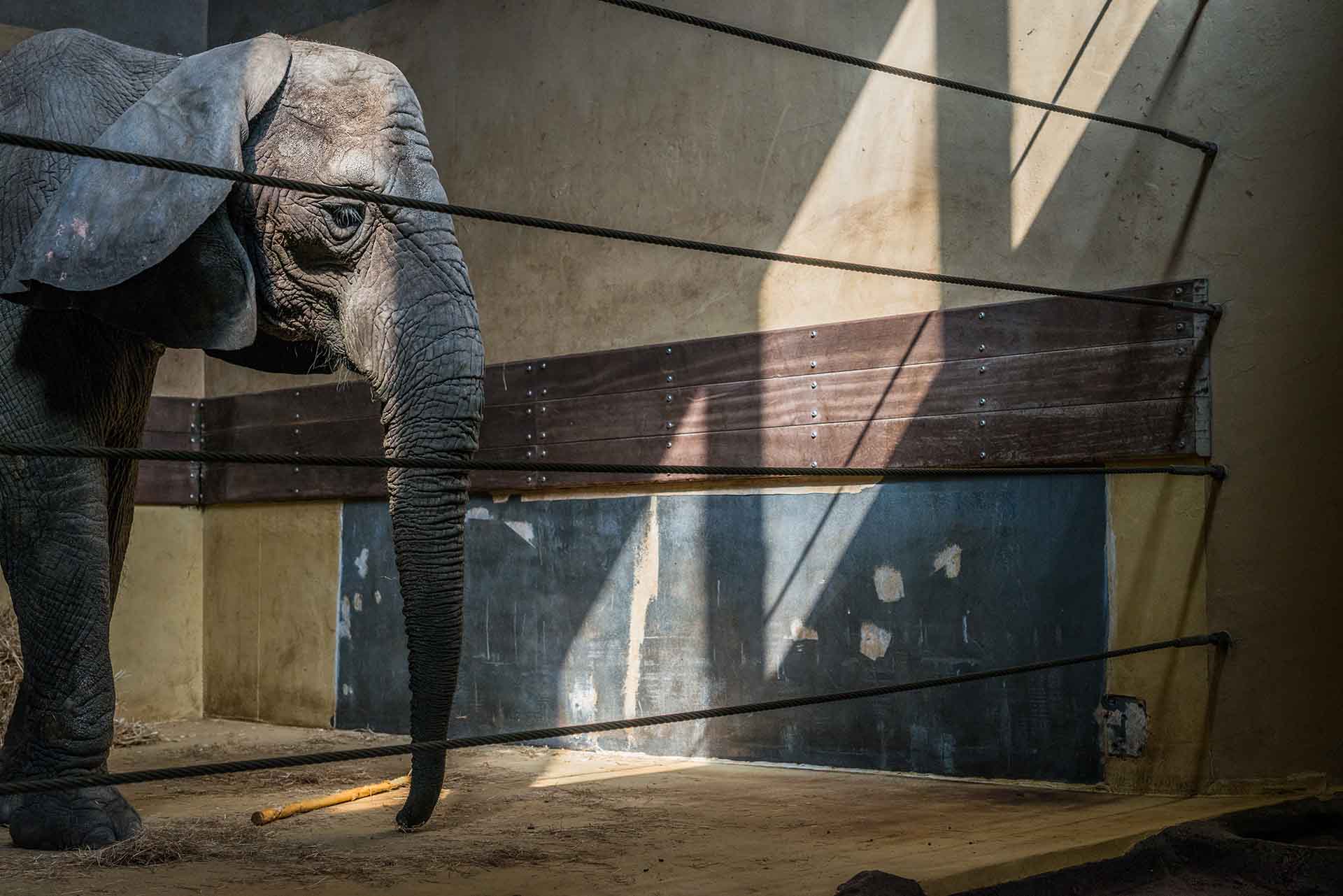
African Elephant At A Zoo In Denmark / Source
What Do Experts Say About Holding Animals Captive?
"Some species. . . are prone to problems that include poor health, repetitive stereotypic behavior, and breeding difficulties. Here we investigate this previously unexplained variation in captive animals' welfare by focusing on caged carnivores and show that it stems from constraints imposed on the natural behavior of susceptible animals, with wide-ranging lifestyles in the wild predicting stereotypy and the extent of infant mortality in captivity. Our findings indicate that the keeping of naturally wide-ranging carnivores should be . . . phased out." (11)
"Many of these same conditions and others are documented in Pathology of Zoo Animals, a review of necropsies conducted by Lynn Griner over the last fourteen years at the San Diego Zoo. This zoo may well be the best in the country, and its staff is clearly well-trained and well-intentioned. Yet this study documents widespread malnutrition among zoo animals; high mortality rates from the use of anesthetics and tranquillizers; serious injuries and deaths sustained in transport; and frequent occurrences of cannibalism, infanticide and fighting almost certainly caused by overcrowded conditions. Although the zoo has learned from its mistakes, it is still unable to keep many wild animals in captivity without killing or injuring them, directly or indirectly. If this is true of the San Diego Zoo, it is certainly true, to an even greater extent, at most other zoos." (12)
Additional Reading
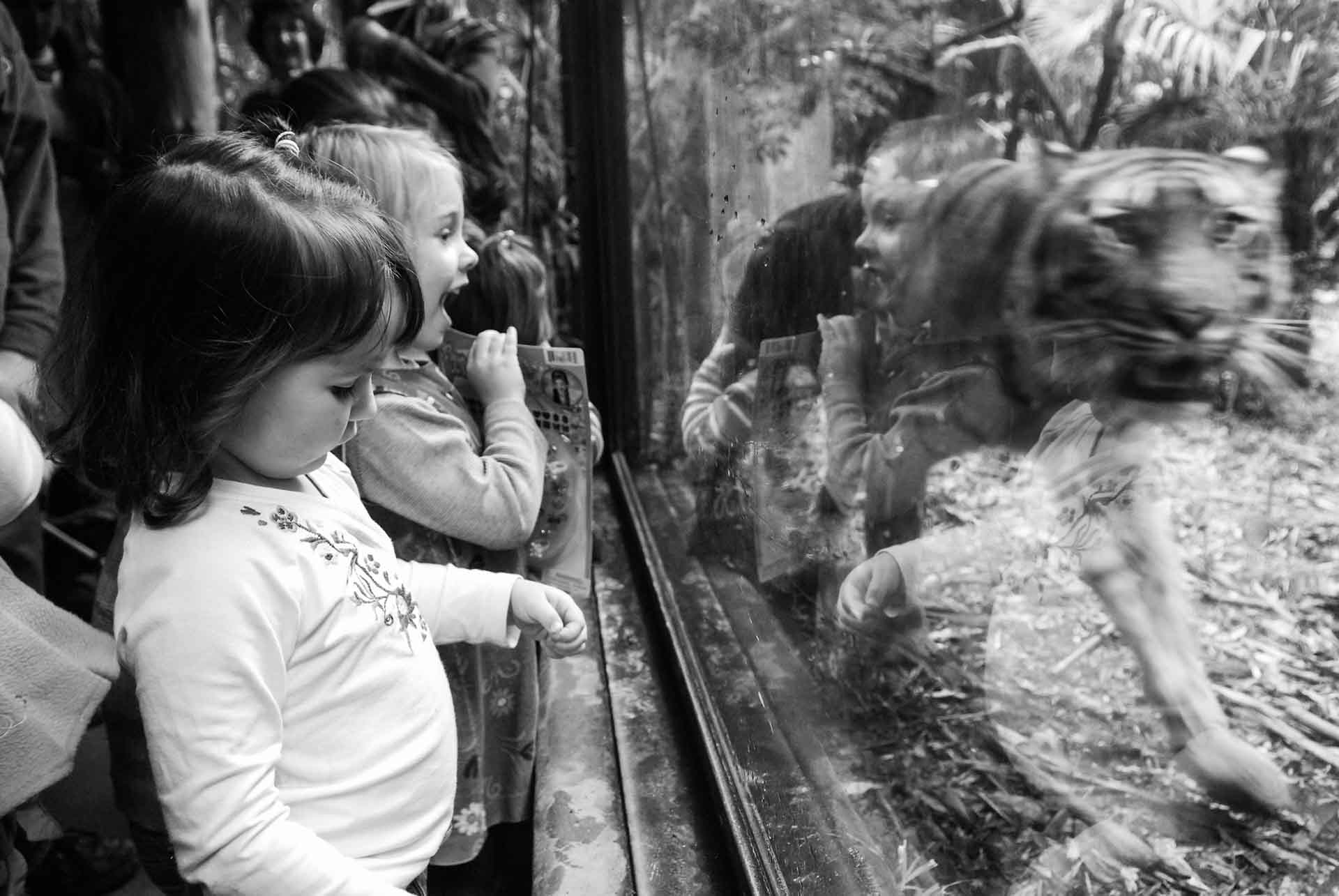
Children watching a pacing tiger / Source
3. Education
Zoos claim to be educational, but is it true?
An educational reputation
Zoos want us to believe that one of their main functions is to serve as an educational institution for the public.
Their decades-long marketing campaigns worked brilliantly.
When polled, 94% of people believe that zoos teach children how to protect animals and their habitats. (1)
But here are the questions we need to ask ourselves:
- Where is the evidence that zoos teach us anything at all?
- If we are to believe they teach us something like the industry claims, even if they do, haven't we already learned it from the hundreds of years we've been caging animals?
And,
- Is the lesson worth an animal spending an entire lifetime in captivity?
And finally,
- Humans accept technological advances in medicines and things like their phones, computers, cars. Why not use this advanced technology to reimagine a way to educate instead of caging animals?
Let's dig deeper.
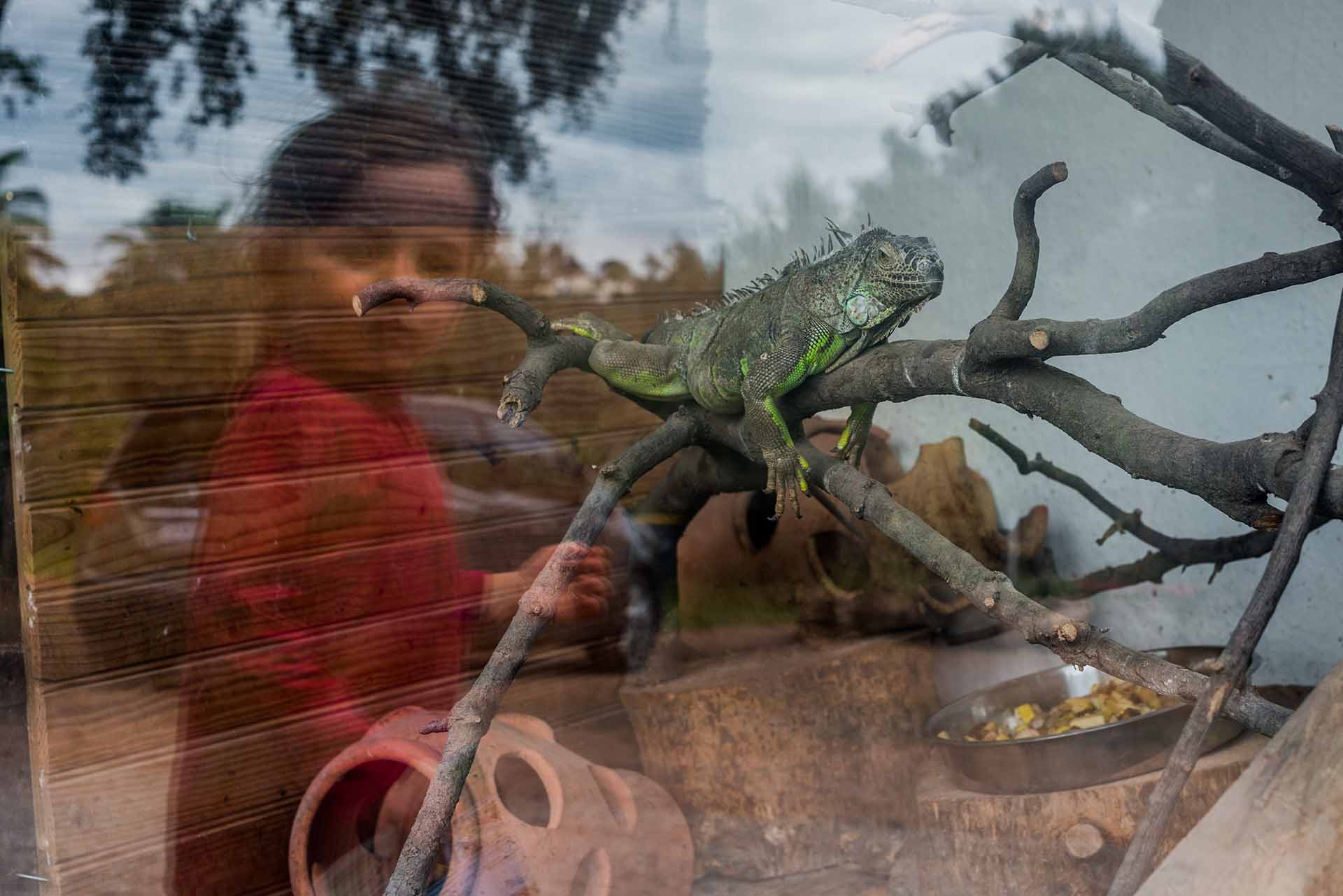
Green Iguana At A Zoo In France / Source
What are zoos teaching us about animals?
For decades, zoos have argued that seeing live animals up close helps to educate and foster interest in the next generation of conservationists.
In reality, these animals are unable to hunt, feed, raise their young, breed, respond to and display affection, fear, pain, hunger, or even use their instincts. How they behave and survive naturally will never be seen by any zoo-goer. Showing animals in an extremely restrictive space misrepresents how they naturally exist.
Insidiously, these places actively teach young people that they are an acceptable part of our society. They portray themselves as an unproblematic participant in wildlife conservation, which is misleading at best.
Do zoos educate people?
While every program varies, many zoos rely on an abundance of signs and educational displays near animal enclosures. But very little of this information, if any at all, will be remembered. Many won't even read it.
One study found the majority of students reported no meaningful change in animal knowledge after visiting a zoo. (13)
Conservationist Damian Aspinall has forty years of experience working with wildlife parks. He observed that one-third of visitors do have improved biodiversity knowledge but found professional zoo-educators can have even better results by working in school environments rather than within a zoological one.
This increased knowledge doesn't necessarily equate to an increase in pro-conservation behavior, though; an average of one percent get newly excited about it after a visit. (14)
That's a low number.
Not only that, but there's also no evidence merely being excited about animals after a visit translates into someone becoming active and involved with helping animals.
We should not be keeping hundreds of thousands of animals in captivity around the world under the guise of education just so that a tiny percentage of people might maybe become active conservationists someday.
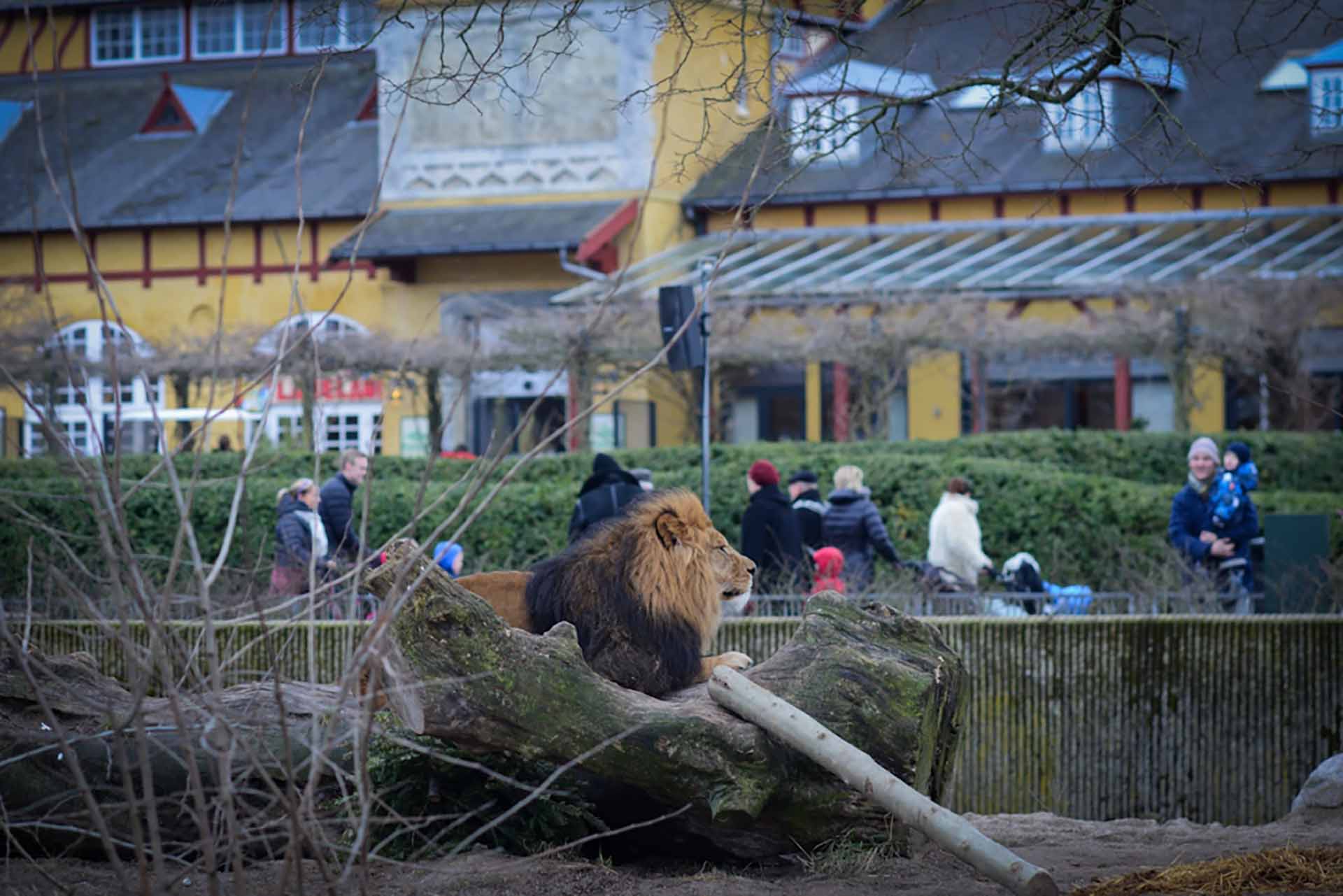
People watching a lion at the Copenhagen Zoo / Source
What the experts say about zoos and education
". . . as memory recedes and the zoo populations become ever more genetically attenuated, ever more conveniently docile, ever more distantly derivative from the real thing, people will find it hard to conceive that those animals were once proud, dangerous, unpredictable, widespread, and kingly, prowling free among the same forests, rivers, estuaries, and oceans used by humanity. Adults, except a few recalcitrant souls, will take their absence for granted. Children will be startled and excited to learn, if anyone tells them, that once there were lions at large in the very world." - David Quamenn, Author Monster is God (15)
"Though I hoped to find evidence to the contrary, I must conclude that zoos continue to be detrimental to animal welfare, and that they do not teach children positive lessons about animals. Kids who watch leopards pacing in mindless patterns get a completely inaccurate picture of what large predators are all about. They also learn that making sentient beings suffer for human amusement is acceptable. We want to teach kids to show kindness towards animals, not stare at their misery while eating popcorn." - Sujatha Ramakrishna, Child Psychiatrist & Author Raising Kids Who Love Animals (16)
Additional reading
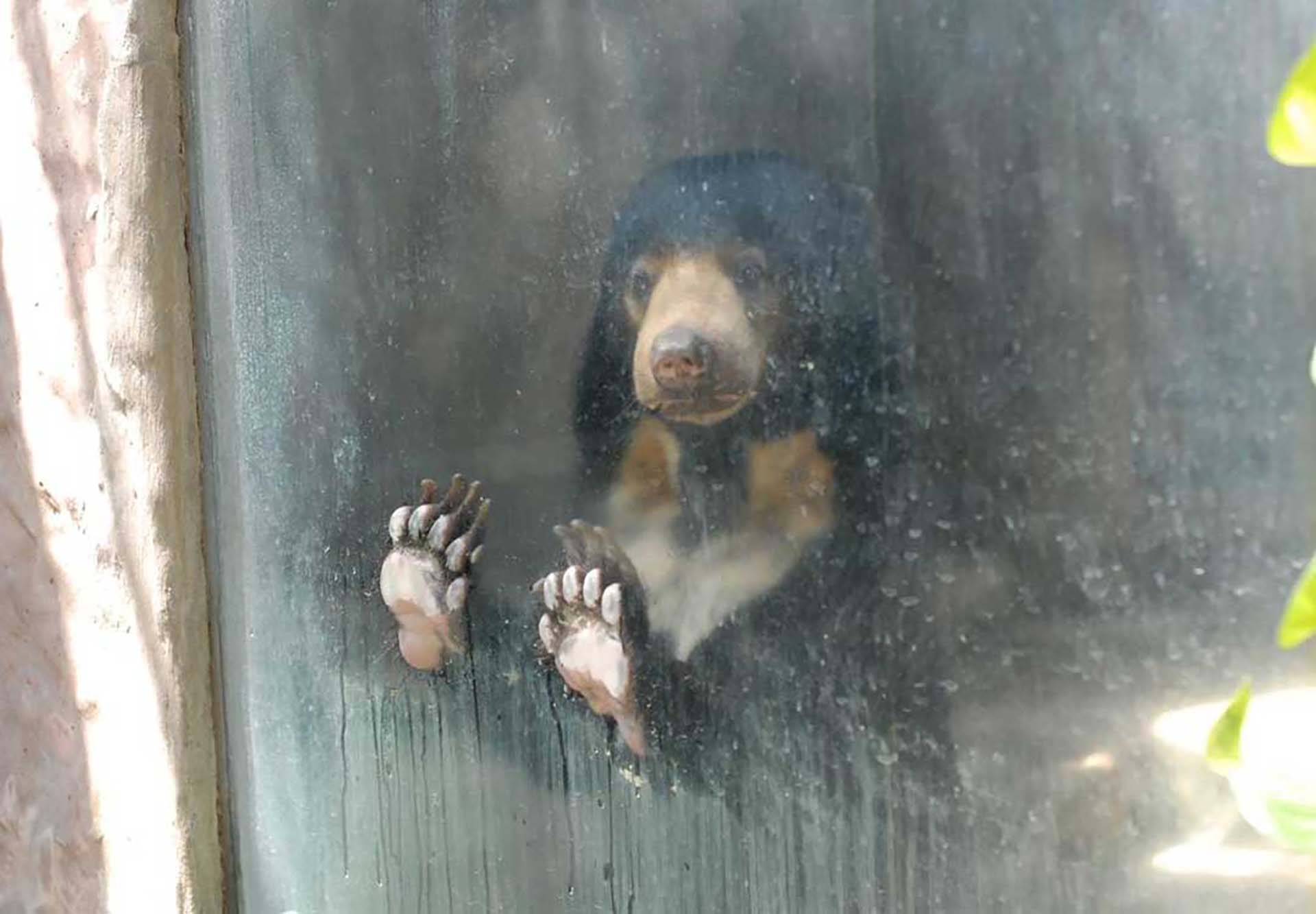
Bear at the Pata Zoo in the Bangkok Pata mall / Source
3. Research
What's being studied, and on whom?
Zoos and research
Zoos support scientific research in various ways. Three common ones are funding field research by scientists not affiliated with zoos, employing scientists as members of the zoological park staff, and making otherwise inaccessible animals available for study. (12)
Even so, few zoos support any real scientific research, and even fewer still will have scientists on staff with full-time research jobs. Among those that do, it's commonplace to have them study free-living animals rather than the animals in zoo collections.
What does studying caged animals tell us?
Research done in zoos is categorized into two categories: behavior studies and anatomy/pathology studies.
But what can studying animals in unnatural settings really tell us about who these animals are and how they live?
"Behavioral research conducted on zoo animals is very controversial. Some have argued that nothing can be learned by studying animals that are kept in the unnatural conditions that obtain in most zoos. Environments trigger behaviors. No doubt a predation-free environment triggers behaviors different from those of an animal's natural habitat, but there is no reason to believe that better, fuller or more accurate data can be obtained in predation-free environments than in natural habitats. There are simply very few zoos that practice relevant and reliable research. Those that do mainly examine the physiological structure of a captive animal, as well as the illnesses he or she has acquired. These results however, are obviously skewed towards animals living in captivity. They therefore generate little information about how to best conserve species in the wild." (12)

Gorilla at a Zoo in Germany / Source
5. Conservation
Do zoological conservation programs work?
The smoke & mirrors of zoological conservation programs
By far, the most recited justification in support of zoological parks is in the conservation of animal species who would otherwise become extinct.
This idea is another half-truth.
Zoos do host conservation programs for endangered species, and some of those programs have indeed had some success.
However, it can be argued that zoos continue to remove more animals from the wild than they return.
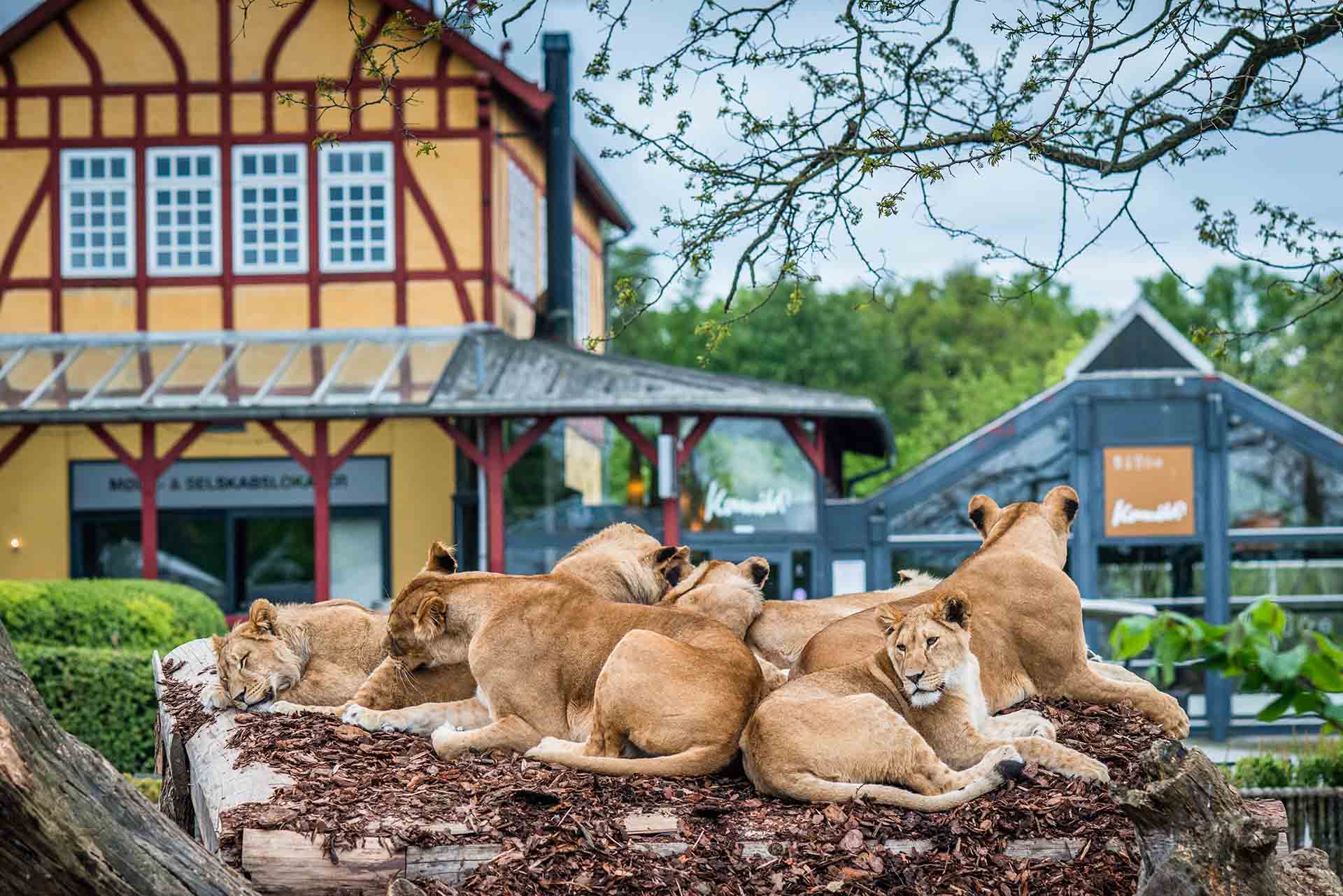
Lions at a Zoological Park in Denmark / Source
The surplus problem
Have you ever wondered where zoological parks get the animals who live there? They have limited capacities and want to maintain a diverse collection (which translates into more money via ticket sales). This balance can only happen with the careful management of their "stock."
One answer is through extensive breeding programs and partnerships with other organizations.
The problem with these types of programs is that they create unwanted animals. In some species (lion, tigers, and zebras, for example), a few male animals can service an entire herd. Extra males are unnecessary as well as a financial burden, and dealing with these and other "surplus" animals is a dirty little industry secret.
Some animals are sold at exotic-animal auctions, putting animals at risk of ending up in the hands of individuals and institutions which lack facilities to care for them properly. Some animals end up at roadside zoos, amusement parks, or tourist attractions, others end up at private hunting preserves where they'll eventually be shot to death by someone who paid for the privilege. And some end up at research laboratories or tested on in university research programs.
But the practice that is perhaps what would be most shocking for the general public to know is what happens to the surplus animals that did not sell.
Feeding animals other animals
The fate of surplus animals that did not sell is bleak; they end up as food for the other animals. Zoological parks engage in this practice for several reasons.
Firstly, feeding zoo animals are expensive; they're not going to waste vast quantities of meat. And secondly, maybe more insidiously, zoos use live feedings as a means of entertainment for visitors.
In 2016, China opened a new tour at a theme park where visitors drive around in a mobile cage through an enclosure with lions, tigers, and bears. The visitors bring live animals with them to feed to the zoo animals. (17) In an attempt to attract more visitors, an Iranian zoo fed live donkeys to the lions at least once a week. (18)
In February of 2014, a healthy young giraffe named Marius was killed at the Copenhagen Zoo because he did not have the genes the zoo conservationist program wanted. His body was then dismembered in front of a crowd and then fed to the zoo's lions. (19)
The practice of feeding animals to other animals is a stark reminder to us all that zoos are, first and foremost, a business.
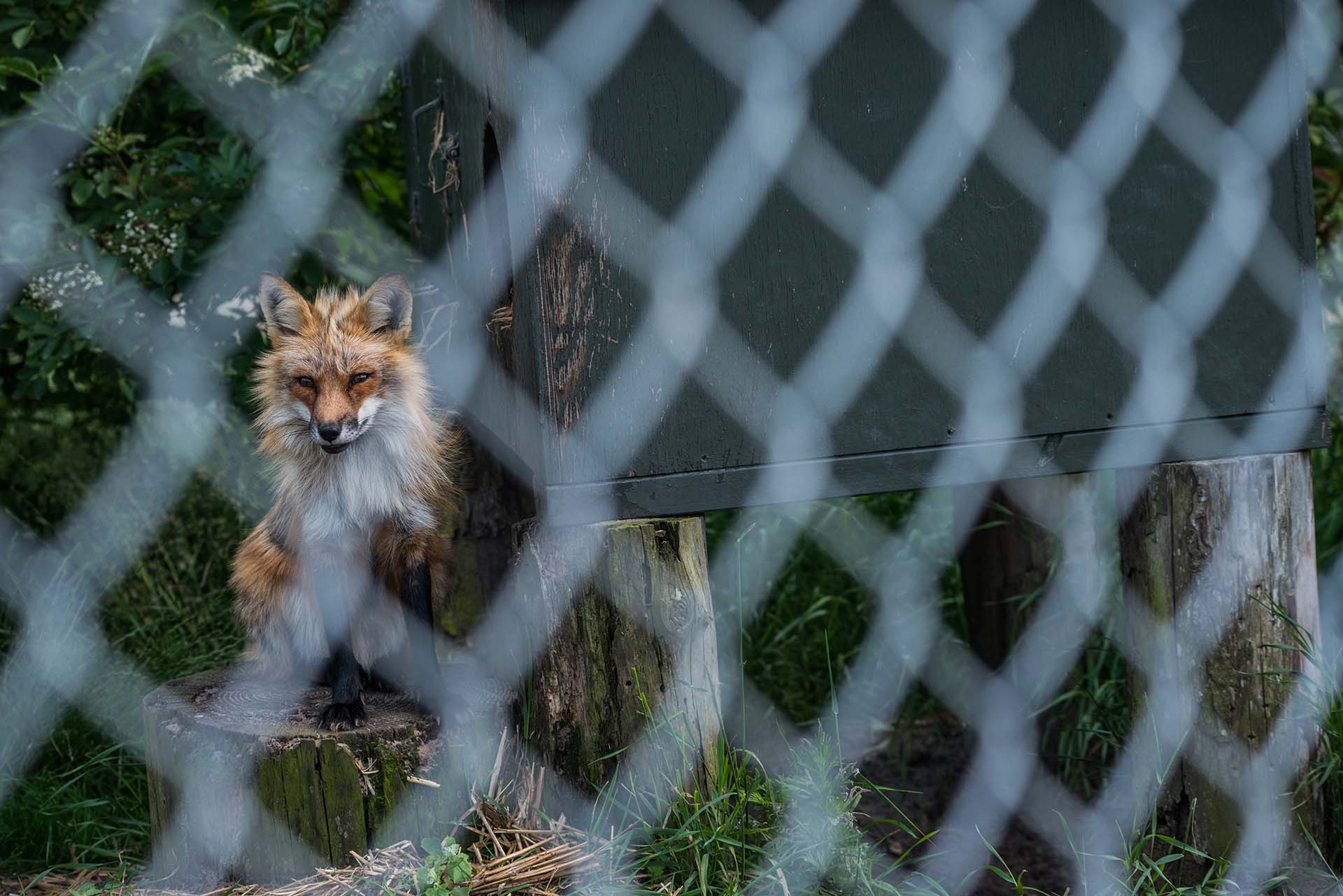
Red Fox at a Zoo in Denmark / Source
The larger question about zoological conservation programs
"There are further questions one might ask about preserving endangered species in zoos. Is it really better to confine a few hapless Mountain Gorillas in a zoo than to permit the species to become extinct? To most environmentalists, the answer is obvious: the species must be preserved at all costs. But this smacks of sacrificing the lower-case gorilla for the upper-case Gorilla. In doing this, aren't we using animals as mere vehicles for their genes? Aren't we preserving genetic material at the expense of the animals themselves? If it is true that we are inevitably moving towards a world in which Mountain Gorillas can survive only in zoos, then we must ask whether it is really better for them to live in artificial environments of our design than not to be born at all." (12)
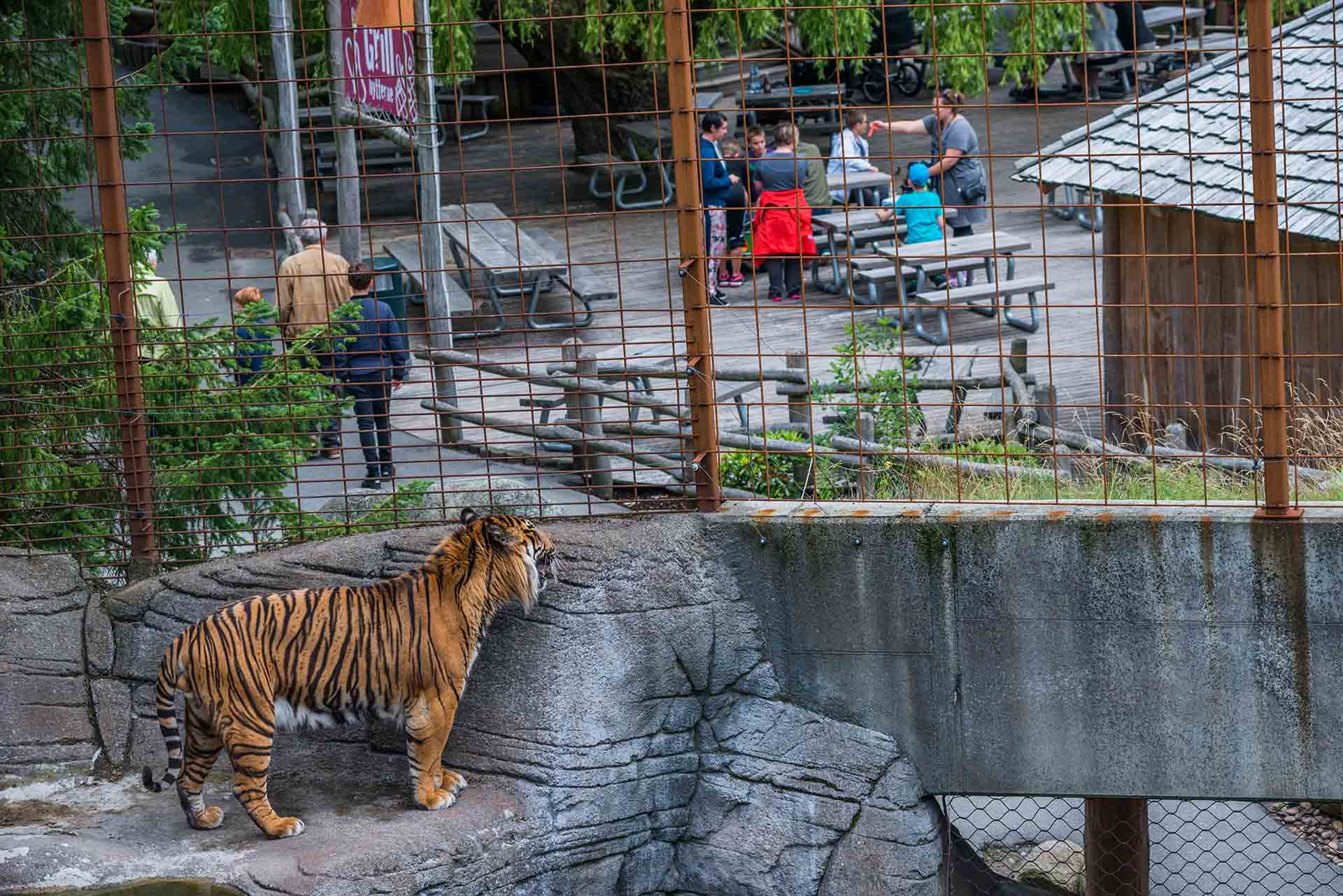
Sumatran Tiger in Denmark / Source
A different path forward
Ironically, some zoos offer visitors hamburger-hotdog style fast food.
The standard American fare for purchase at zoos is part of the disconnect that patrons swallow at each visit: Certain animals are to be enjoyed through a gate or glass, those are available for purchase as stuffed animals or t-shirts on the way out. Others are to be eaten, passed off as the kid's meal at the zoo café.
If the goal is to conserve as many animals as possible, then there are better ways to go about it.
To start, defund zoological breeding programs. Instead, redirect those resources to habitat preservation, a root cause of extinction in the first place. In lieu of spending hundreds of thousands of dollars on state-of-the-art enclosures, rebuild natural areas where habitat preservation isn't possible.
And finally, it cannot be overlooked how the production of meat and dairy products contributes to environmental destruction, and by default, habitat loss.
Community conversations about zoological conservation programs
"By avoiding animal products, zoos, aquaria, animal racetracks and the like, vegans erode the power of the institutions that breed domestic animals into existence as commodities- institutions that, at the same time, use habitat needed by autonomous animals." - Lee Hall, Author (1)
"It makes no sense to support zoos in general and then express anger...about [the] disposal of... surplus inventory. Rather, as we evolve...our relationships with other species must...evolve; it is time for us to stop viewing their members as objects for our amusement." - Karen Dawn, Author (20)
Additional reading
6. Family-friendly Zoo Alternatives
Because we all love animals.
Do these instead of visiting a zoo
Zoos can be a busy hub of activity, and parents might worry that skipping the zoo means their children are missing out. Not so! There are many alternatives to visiting the zoo that helps children connect with and learn more about animals.
Here are a few activities to do instead of going to the zoo.
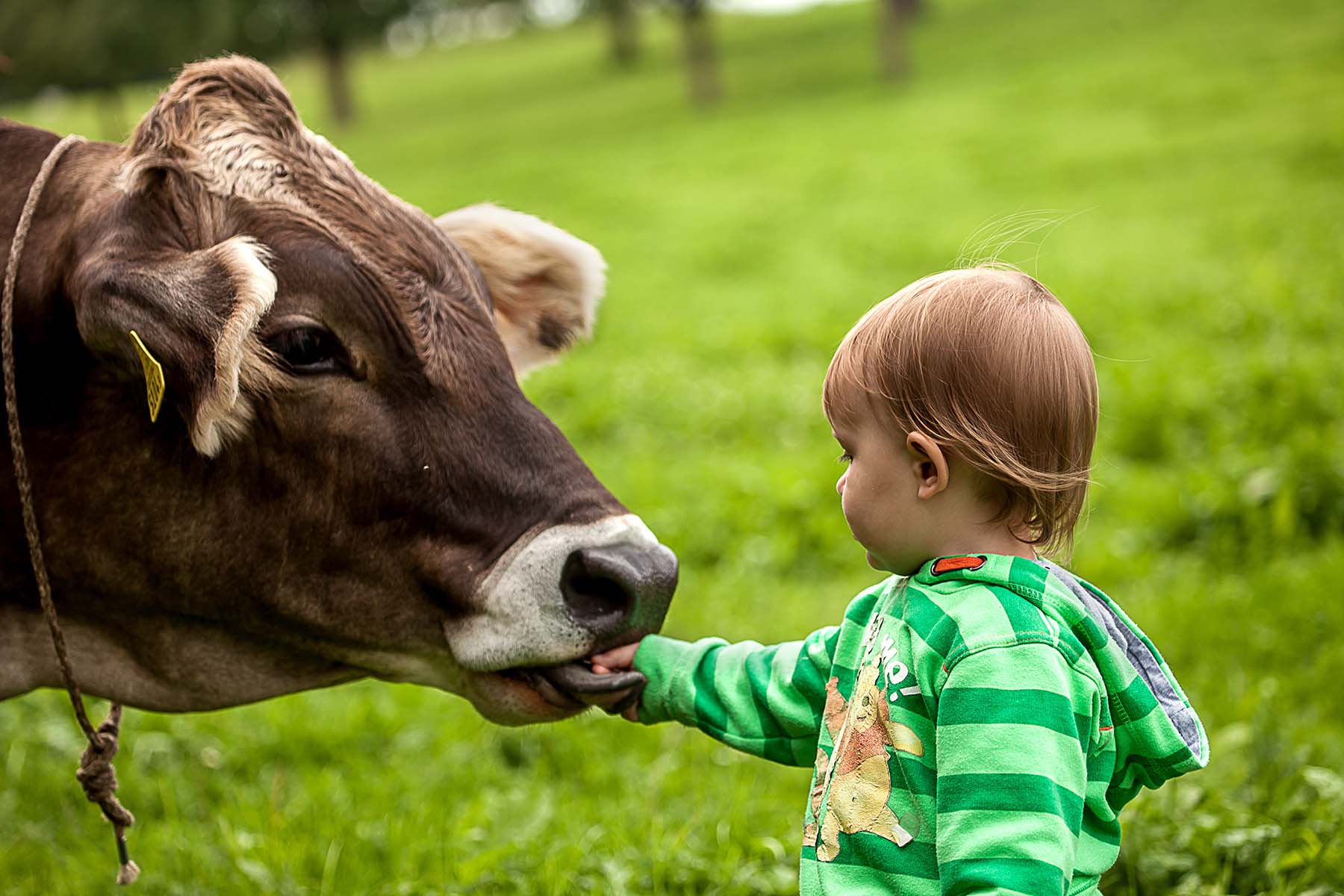
A child and a cow / Source
Visit an animal sanctuary
Animal sanctuaries are veganism's greatest advocates and the perfect alternative to visiting a zoo. They are a physical space that allows people to "connect with animals" in a way that a zoo cannot replace.
Visitors are able to interact with animals in a peaceful and natural setting, allowing a greater understanding of their lives as individuals.
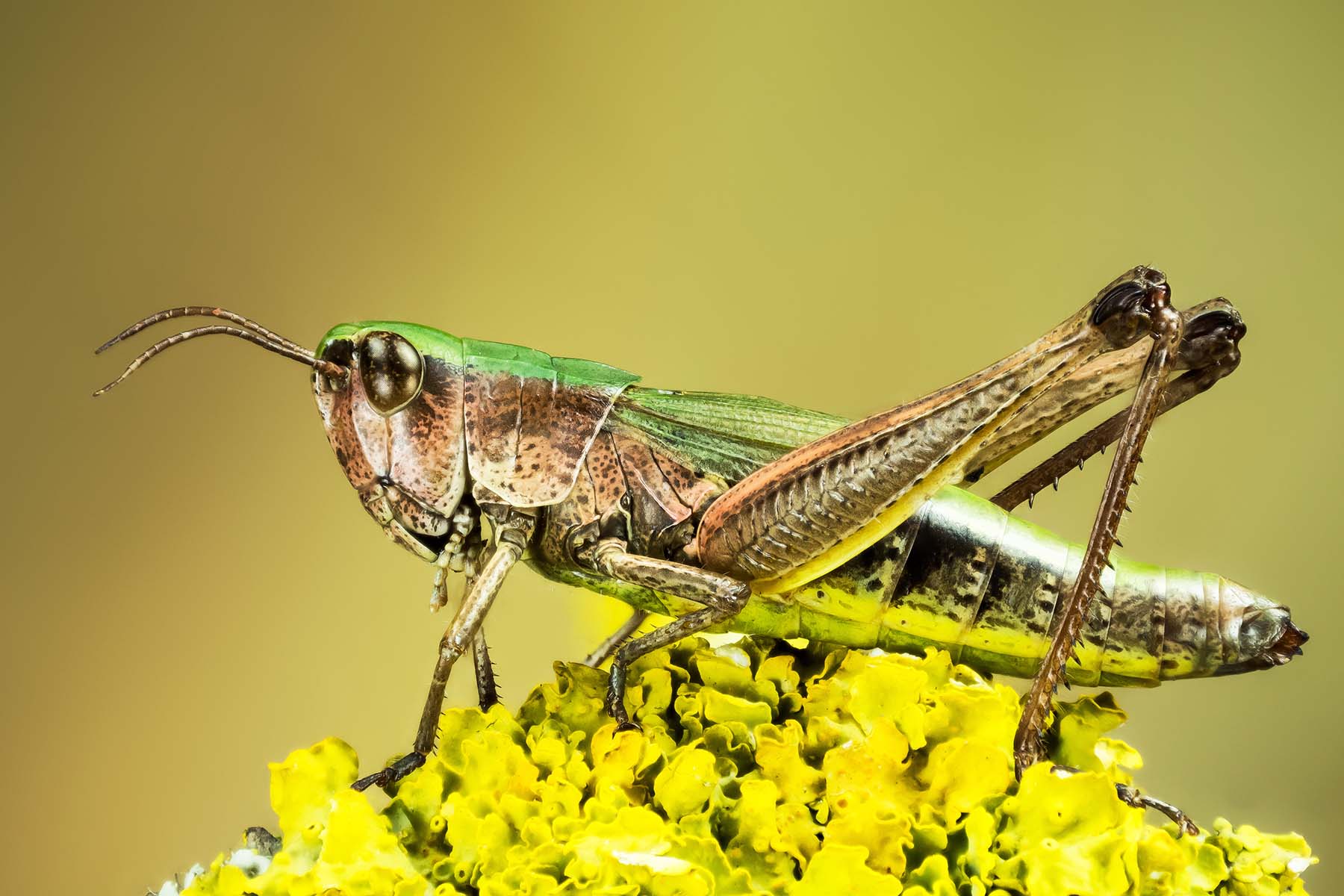
Lesser Marsh Grasshopper / Source
Observe local animal habitats
One of the easiest ways to teach children about animals is to simply walk outside. There is abundant animal life right outside our back doors. Learn about local plants, trees, and all of the different species of animals in your area.

Cover for the TV series, Planet Earth / Source
Watch educational documentaries
Programs such as Planet Earth have stunning visuals and excellent commentary for learning and entertainment. Visit the Vegan Movie Library and the Vegan Netflix Guide to find more movies and TV shows with a compassionate message to help teach children kindness.
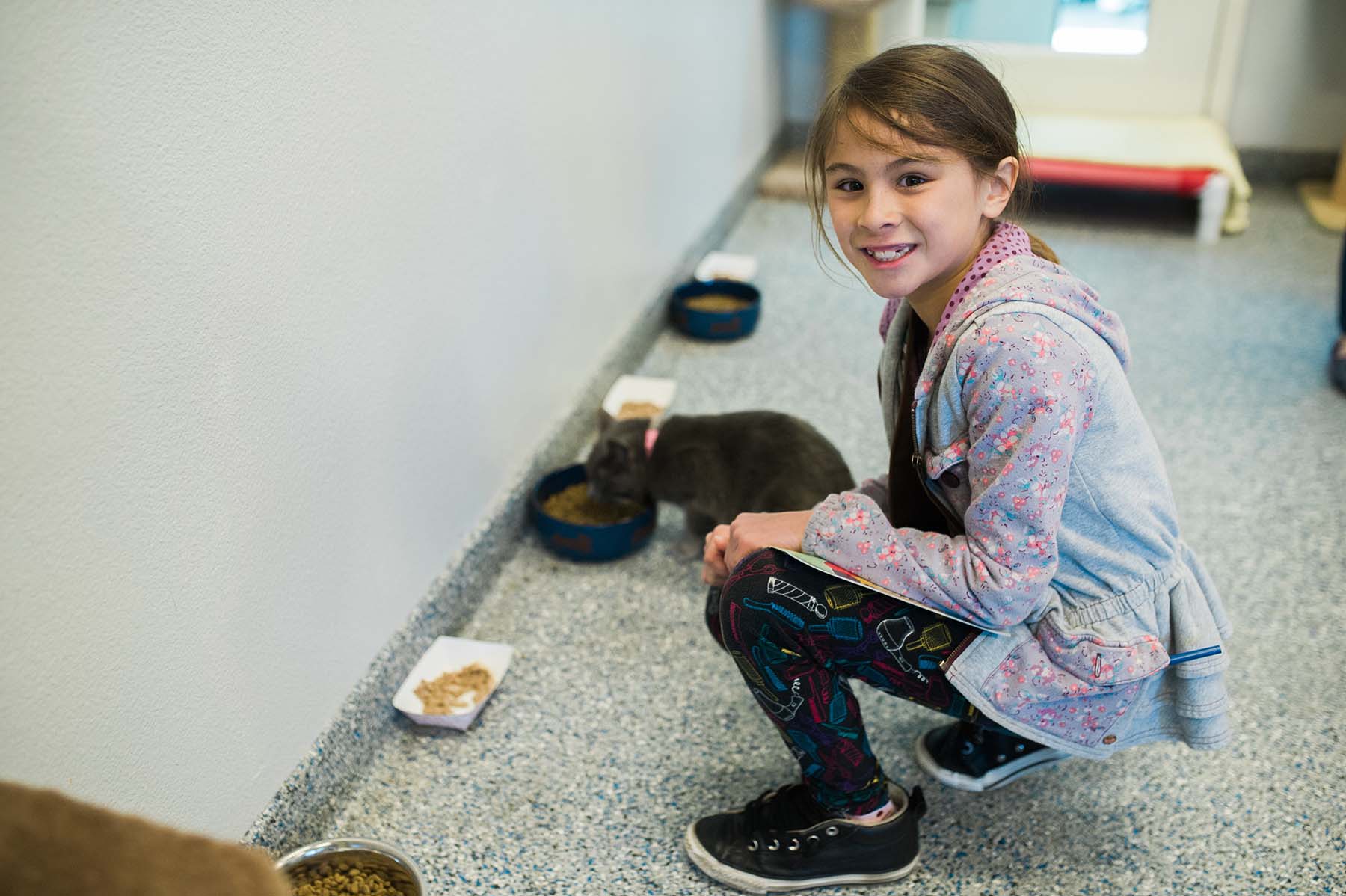
A child volunteering at a cat shelter / Source
Walk dogs or care for other animals at a shelter
This is hands-on experience with animals who desperately need the TLC, plus children will learn how to give comfort (be kind) to animals.

An adult & child hiking / Source
Visit parks, hiking trails, or other outdoor public spaces
Grab a pair of binoculars and head to the park or trail. Look for different types of animals in the area- make a game out of counting numbers of animals spotted.
Learning more about the local animal life not only teaches children about the lives of animals, but also how to coexist with them.

Child with laptop learning nature online at home / Source
Use online educational tools
Open up the laptop and visit websites dedicated to helping children learn more about animals. The following are websites educate in a fun and engaging way:

Children at the library / Source
Read and share books together
There are lots of books to help explain an ethical worldview in a way that children will understand and enjoy.
Browse below or visit the Vegan Book Library for the full collection of vegan children’s books.
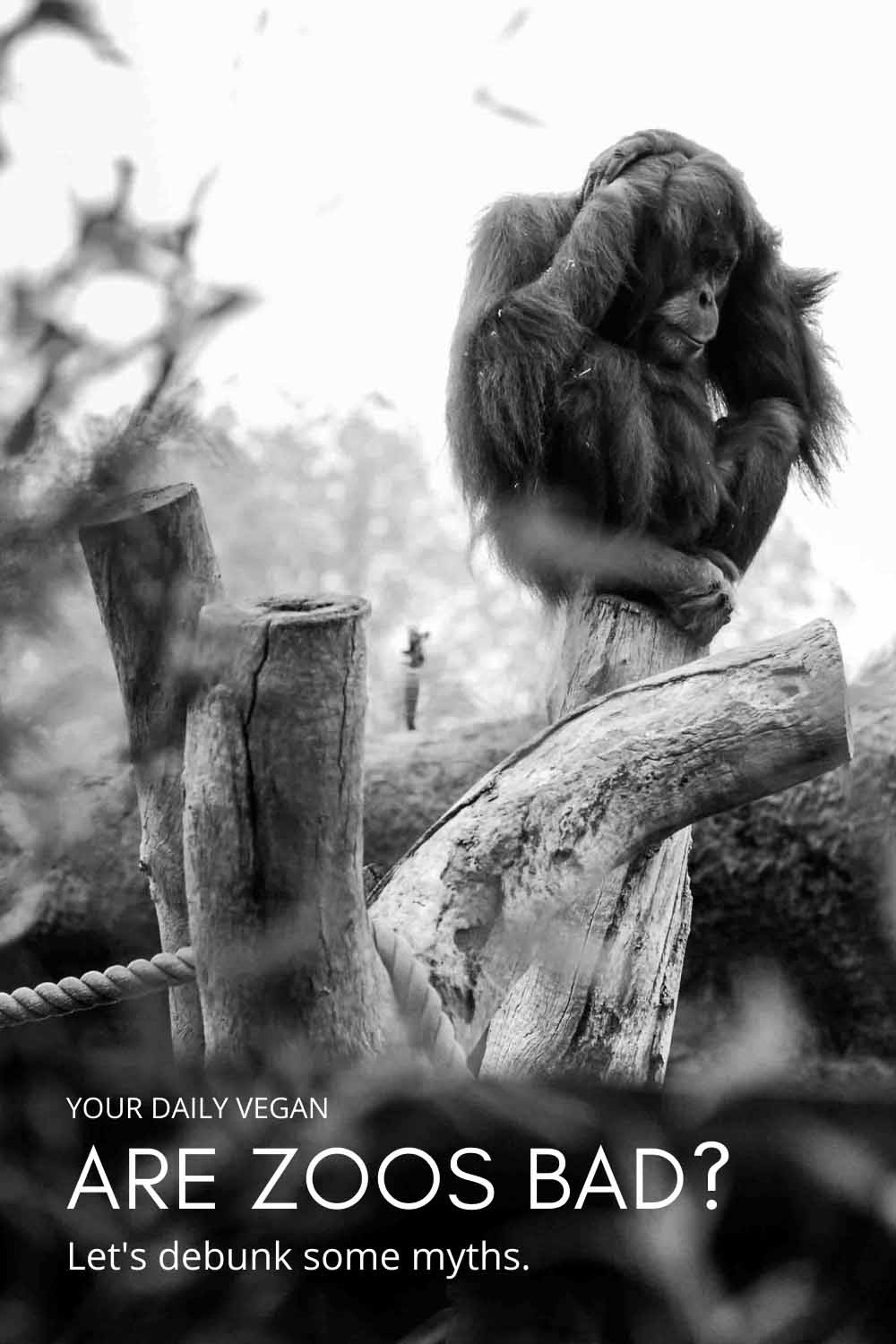
Truth in advertising
I am committed to providing accurate information to the vegan community. Meticulously researched, the topic explored in this guide contains the information available at the time of publishing.
I don’t just say it; I source it too.
Please contact me if you find incorrect data.

